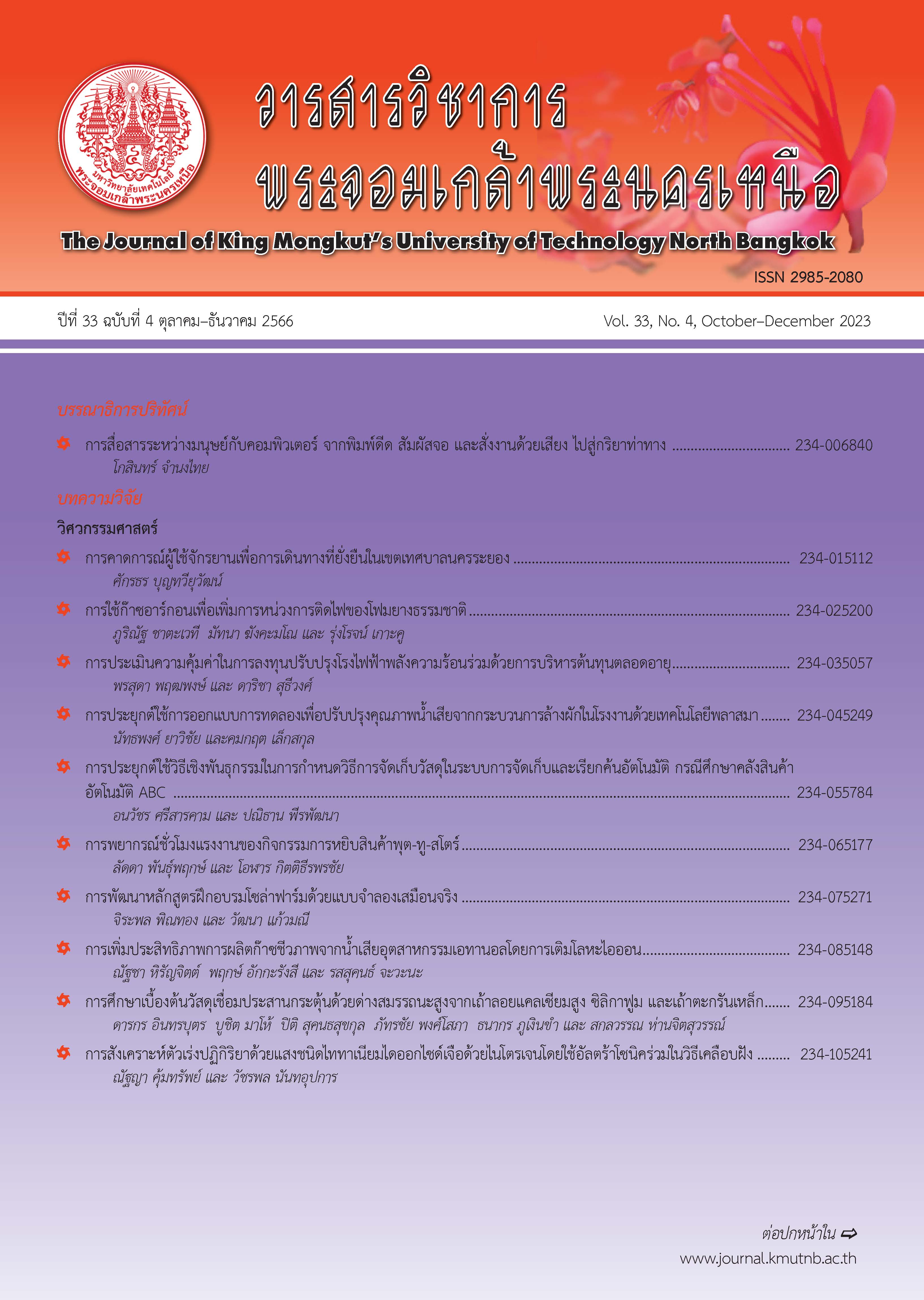การเปรียบเทียบขั้นตอนวิธีแบบเบย์อย่างง่ายและซัพพอร์ตเวกเตอร์แมชชีน เพื่อพัฒนาแบบจำลองการทำนายบทวิจารณ์ร้านอาหาร
Main Article Content
บทคัดย่อ
คนไทยให้ความสนใจเรื่องอาหาร เนื่องจากอาหารเป็นหนึ่งในปัจจัยสำคัญสำหรับการดำเนินชีวิตและยังเป็นส่วนหนึ่งของวัฒนธรรมไทย โดยที่ผู้บริโภคนิยมเขียนบทวิจารณ์เกี่ยวกับอาหาร เพื่อแบ่งปันประสบการณ์ของตนให้กับเพื่อนบนเครือข่ายสังคมออนไลน์ ทำให้บทวิจารณ์เกี่ยวกับอาหารและร้านอาหารมีมากมายและอยู่กันอย่างกระจัดกระจาย บทความนี้นำเสนอแบบจำลองแนะนำร้านอาหารจากบทวิจารณ์ในทวิตเตอร์ เรียกว่า ฟู้ดฟายเดอร์ โดยแบ่งระดับของบทวิจารณ์เป็น 3 ประเภท ได้แก่ บทวิจารณ์ด้านบวก เป็นกลาง และลบ แบบจำลองดังกล่าวรวบรวมบทวิจารณ์จากเครือข่ายสังคมออนไลน์ทวิตเตอร์ (เอ็กซ์) จำนวน 1,490 บทวิจารณ์ และวิเคราะห์ข้อมูลโดยใช้ขั้นตอนวิธีแบบนาอีฟเบย์ เปรียบเทียบกับขั้นตอนวิธีแบบซัพพอร์ตเวกเตอร์แมชชีน ผลที่ได้พบว่า ค่าความถูกต้องในการทำนายประเภทของบทวิจารณ์ด้วยวิธีแบบซัพพอร์ตเวกเตอร์แมชชีนได้รับค่าความถูกต้องร้อยละ 82.89 ซึ่งมากกว่าวิธีนาอีฟเบย์ ที่ได้รับค่าความถูกต้องร้อยละ 80.20 และเมื่อทดสอบกับข้อมูลใหม่พบว่า แบบจำลองด้วยวิธีแบบซัพพอร์ตเวกเตอร์แมชชีนได้รับค่าความถูกต้อง ร้อยละ 80.87 ส่วนวิธีนาอีฟเบย์ได้รับค่าความถูกต้อง ร้อยละ 78.86 นอกจากนั้น บทความนี้ยังได้นำเสนอการวิเคราะห์ข้อมูลโดยการนับจำนวนคำ แฮชแท็ก และสัญลักษณ์ที่ปรากฏในบทวิจารณ์โดยการนับความถี่ เพื่อเพิ่มความถูกต้องในการทำนายประเภทบทวิจารณ์
Article Details

อนุญาตภายใต้เงื่อนไข Creative Commons Attribution-NonCommercial-NoDerivatives 4.0 International License.
บทความที่ลงตีพิมพ์เป็นข้อคิดเห็นของผู้เขียนเท่านั้น
ผู้เขียนจะต้องเป็นผู้รับผิดชอบต่อผลทางกฎหมายใดๆ ที่อาจเกิดขึ้นจากบทความนั้น
เอกสารอ้างอิง
Kasikorn Bank. (2017). 5 Business Trends that surpass of 2017. Kasikorn Bank. Bangkok. Thailand [Online]. (in Thai). Available: https:// www.kasikornbank.com/th/business/sme/ KSMEKnowledge/article/KSMEAnalysis/ Documents/5BusinessTrendsOf2017.pdf.
CleverKid. (2015). Eat share connect: Hot lifestyle in the era of the single app. iReview. Bangkok. Thailand [Online]. (in Thai). Available: https://ireview.in.th/pr-eat-share-connectlifestyle- force/.
Google Trends. (2017). See what was trending in 2017 - Thailand. [Online]. (in Thai). Available: http://trends.google.com/trends/yis/2017/TH.
B. Vutidhammakhun, “The social media restaurant reviews and the decision making in choosing restaurant in Bangkok,” B. M. Com. Arts thesis, Independent Study of Graduate School, Digital Marketing Communications, Bangkok University, 2017 (in Thai).
J. Dancy, (2012). Dine and Dish: Are Social Media and Food the Perfect Pairing. [Online]. Available: https://www.columnfivemedia.com/ work-items/infographic-dine-and-dish-aresocial- media-and-food-the-perfect-pairing.
Bright Local. (2017). Local Consumer Review Survey 2017. [Online]. Available: https://www. brightlocal.com/learn/local-consumer-reviewsurvey/
R. Burke, “Hybrid web recommender systems,” The Adaptive Web, vol. 4321, pp. 377–408, 2007.
W.T. Gao, W. Yu, P. Chao, R. Zhang, A. Zhou, and X. Yang, “A restaurant recommendation system by analyzing ratings and aspects in reviews,” International Conference on Database Systems for Advanced Applications. vol. 9050, pp. 526–530, 2015.
S. Higgs and J. Thomas, “Social influences on eating,” Current Opinion in Behavioral Sciences, vol. 9, pp. 1–6, 2016.
I. K. C. U. Perera and H. A. Caldera, “Aspect based opinion mining on restaurant reviews,” presented at the 2nd IEEE International Conference on Computational Intelligence and Applications (ICCIA), Beijing, China, Sep. 8–11, 2017.
Y. M. Aye and S. S. Aung, “Sentiment analysis for reviews of restaurants in Myanmar text,” presented at the 18th IEEE/ACIS International Conference on Software Engineering, Artificial Intelligence, Networking and Parallel/Distributed Computing (SNPD), Kanazawa, Japan, Jun. 26–28, 2017.
J. B. Schafer, J. A. Konstan, and J. Riedl, “E-commerce recommendation applications,” Data Mining and Knowledge Discovery, vol. 5, pp. 115–153, 2001.
N. G. Bhojne, S. Deore, R. Jagtap, G. Jain and C. Kalal, “Collaborative approach based restaurant recommender system using naive bayes,” International Journal of Advanced Research in Computer and Communication Engineering, vol. 6, no. 4, pp. 6–13, 2017.
P. Sasikala and M. I. S. Lourdusamy, “Sentiment analysis of online food reviews using customer ratings,” International Journal of Pure and Applied Mathematics, vol. 119, no. 15, pp. 3509– 3514, 2018.
B. Yu, J. Zhou, Y. Zhang, and Y. Cao. (2017, September). Identifying restaurant features via sentiment analysis on yelp reviews. arXiv. [Online]. Available: https://arxiv.org/abs/ 1709.08698
N. Raul, Y. Shah, and M. Devganiya, “Restaurant revenue prediction using machine learning,” International Journal of Engineering and Science, vol. 6, no. 4, pp. 2319–6483, 2016.
W. T. Chu and Y. L. Tsai, “A hybrid recommendation system considering visual information for predicting favorite restaurants,” World Wide Web Journal: Internet and Web Information Systems Manuscript, vol. 20, no. 6, pp. 1313– 1331, 2017.
F. Nurifan, R. Sarno, and K. S. Sungkono, “Aspect based sentiment analysis for restaurant reviews using hybrid ELMo-wikipedia and hybrid expanded opinion lexicon-senticircle,” International Journal of Intelligent Engineering and Systems, vol. 12, no. 6, pp. 47–58, 2019.
J. D. M. Rennie, L. Shih, J. Teevan, and D. R. Karger, “Tackling the poor assumptions of naïve bayes text classifiers,” in Proceedings of the Twentieth International Conference on Machine Learning (ICML-2003), 2003.
T. Fletcher, Support Vector Machines Explained. London's Global University: UK, 2008.
J. Davisand and M. Goadrich, “The relationship between Precision-Recall and ROC curves,” in Proceedings the 23rd International Conference on Machine Learning, 2006, pp. 233–2

